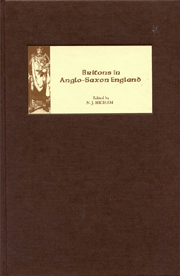Book contents
- Frontmatter
- Contents
- List of Illustrations
- List of Tables
- Contributors
- Dedication
- Acknowledgements
- Abbreviations
- 1 Britons in Anglo-Saxon England: An Introduction
- 2 Anglo-Saxon Attitudes
- 3 Forgetting the Britons in Victorian Anglo-Saxon Archaeology
- 4 Romano-British Metalworking and the Anglo-Saxons
- 5 Invisible Britons, Gallo-Romans and Russians: Perspectives on Culture Change
- 6 Historical Narrative as Cultural Politics: Rome, ‘British-ness’ and ‘English-ness’
- 7 British Wives and Slaves? Possible Romano-British Techniques in ‘Women's Work’
- 8 Early Mercia and the Britons
- 9 Britons in Early Wessex: The Evidence of the Law Code of Ine
- 10 Apartheid and Economics in Anglo-Saxon England
- 11 Welsh Territories and Welsh Identities in Late Anglo-Saxon England
- 12 Some Welshmen in Domesday Book and Beyond: Aspects of Anglo-Welsh Relations in the Eleventh Century
- 13 What Britons Spoke around 400 AD
- 14 Invisible Britons: The View from Linguistics
- 15 Why Don't the English Speak Welsh?
- 16 Place-Names and the Saxon Conquest of Devon and Cornwall
- 17 Mapping Early Medieval Language Change in South-West England
- Index
4 - Romano-British Metalworking and the Anglo-Saxons
Published online by Cambridge University Press: 12 September 2012
- Frontmatter
- Contents
- List of Illustrations
- List of Tables
- Contributors
- Dedication
- Acknowledgements
- Abbreviations
- 1 Britons in Anglo-Saxon England: An Introduction
- 2 Anglo-Saxon Attitudes
- 3 Forgetting the Britons in Victorian Anglo-Saxon Archaeology
- 4 Romano-British Metalworking and the Anglo-Saxons
- 5 Invisible Britons, Gallo-Romans and Russians: Perspectives on Culture Change
- 6 Historical Narrative as Cultural Politics: Rome, ‘British-ness’ and ‘English-ness’
- 7 British Wives and Slaves? Possible Romano-British Techniques in ‘Women's Work’
- 8 Early Mercia and the Britons
- 9 Britons in Early Wessex: The Evidence of the Law Code of Ine
- 10 Apartheid and Economics in Anglo-Saxon England
- 11 Welsh Territories and Welsh Identities in Late Anglo-Saxon England
- 12 Some Welshmen in Domesday Book and Beyond: Aspects of Anglo-Welsh Relations in the Eleventh Century
- 13 What Britons Spoke around 400 AD
- 14 Invisible Britons: The View from Linguistics
- 15 Why Don't the English Speak Welsh?
- 16 Place-Names and the Saxon Conquest of Devon and Cornwall
- 17 Mapping Early Medieval Language Change in South-West England
- Index
Summary
THE decline in manufacturing which characterized late Roman Britain and the early post-Roman period has caused real difficulties in assessing the extent and degree of continuity which Anglo-Saxon workmanship exhibits with earlier Insular production, but metalworking is perhaps the one exception which can enable us to explore this interface. This paper will, therefore, seek to examine evidence for contact between Anglo-Saxon artificers and consumers of metalwork and traditions of production in late Roman and early post-Roman Britain. In the late Roman period in Britain, there is evidence for the development of distinctive types of personal adornment, which seem in general to be larger than their antecedents and to be made on occasion in silver, pointing to a new importance attached to these items as signifiers of social status. It may be pointed out that brooches, though ubiquitous in first- and second-century contexts in Britain, generally fell out of fashion in the third, the only types to remain in use being the crossbow, disc and penannular types. Crossbow brooches, which were particularly used as marks of rank, do not seem to have been produced after the end of the Roman period, but their possible influence on the design of some Anglo-Saxon metalwork is discussed below. The use of brooches as insignia of office was well-established by the end of the Roman period and continued as late as the tenth century: Constantine Porphyrogenitos documents a ceremony in which the emperor pinned a fibula on the shoulder of a new official.
- Type
- Chapter
- Information
- Britons in Anglo-Saxon England , pp. 42 - 56Publisher: Boydell & BrewerPrint publication year: 2007



